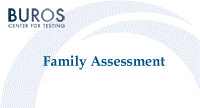Buros-Nebraska Series on Measurement and Testing

Family Assessment
Date of this Version
1995
Document Type
Article
Citation
Family Assessment, ed. Jane Close Conoley & Elaine Buterick Werth (Lincoln, NE: Buros Institute of Mental Measurements, University of Nebraska-Lincoln, 1995).
Abstract
The previous chapters have illustrated in great depth the intricacies of family assessment. The meaning of family across cultures, the effects of emotional, physical, and mental challenges on family functioning, and the frameworks useful in defining important family constructs have all been explored.
Although there are many measures for the many constructs that have been created to capture the meaning of family interaction, most are rather exploratory or useful only with limited populations. Clinical judgement and research acumen are required to be sure valid assessments are accomplished. There are significant challenges left to meet in designing assessment programs to illuminate important elements of family life such as marital quality, parent-child interactions, sibling interactions, the effects of stress associated with divorce, special needs children, or poor health.
Expert family assessment requires a clear grounding in a theory of families-a theory that can expand to include families from many cultural and groups. Measurement devices and approaches are most useful for clinical applications when they are embedded in such a theoretical network. Several such approaches may exist, but they remain untested across heterogeneous groups of families.
Expert family assessment requires a sensitivity to the myriad interactions that create family life. The skill of identifying which of those interactions make up a pattern with significant clinical importance is critical to meaningful assessment.
Although a human system in which almost everyone partakes, the family has clinical and theoretical mysteries yet unsolved. To what extent is the family environment shared? To what extent is each person's experience a unique variant of family patterns? What combination of individual attributes, interactional skills, and external stresses and supports makes for family success or dysfunction? How amenable to intervention are the many components of family life?
Perhaps an excellent book answers numerous questions while posing and framing many, many more. This is such a work.
Included in
Educational Assessment, Evaluation, and Research Commons, Family, Life Course, and Society Commons, Quantitative, Qualitative, Comparative, and Historical Methodologies Commons


Comments
Copyright © 1995 by Buros Institute of Mental Measurements. Digital Edition copyright © 2012 Buros Center for Testing.